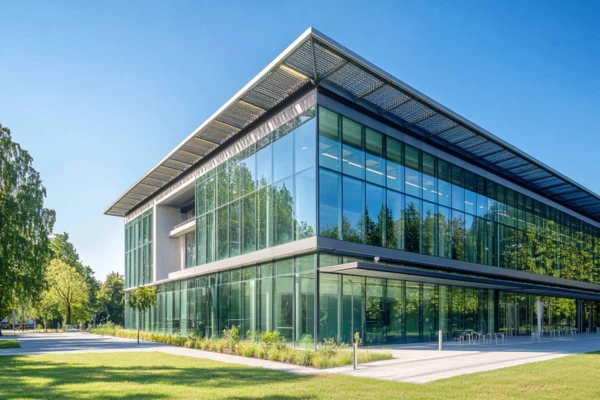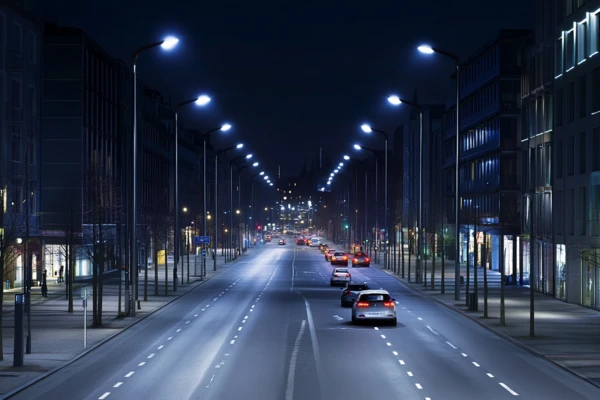Light meets intelligence: How AI is transforming the lighting industry
The lighting industry is in the midst of a profound transformation, driven by the rapid development of artificial intelligence (AI). What were once simple, static lighting systems are now evolving into intelligent, adaptive networks that do far more than just provide light. For medium-sized companies in this sector, this not only means technological innovation, but also a strategic realignment. This article examines the diverse potential, but also the challenges, associated with the integration of AI in lighting systems and shows ways in which companies can use this technology effectively in order to remain competitive and open up new areas of business.
Basics of AI integration in lighting systems
To understand the full potential of AI in the lighting industry, it is important to understand the basic concepts and benefits of this technology. In the following, we will explain what AI-controlled lighting is and what advantages it offers over conventional systems.
What is AI-controlled lighting?
AI-controlled lighting refers to systems that use artificial intelligence and machine learning to adapt autonomously to changing conditions and make decisions that would traditionally require human intervention. This includes analyzing environmental data such as brightness, movement and even user biometric information. Through advanced algorithms, these systems can recognize patterns, make predictions and optimize lighting settings in real time. For example, an AI system can increase lighting levels if it detects that employees are losing concentration, or adjust the color temperature to support natural biorhythms.
Advantages over conventional systems
In contrast to traditional lighting systems, which are often rigid and inefficient, AI-controlled solutions offer a number of advantages:
Greater energy efficiency through needs-based lighting
Improved user experience through personalized lighting scenarios
Lower maintenance costs thanks to predictive maintenance
More flexible adaptation to changing requirements
Core areas of AI application in lighting
The application of AI in lighting systems spans several key areas, each offering specific benefits and opportunities. Below we highlight the key application areas where AI is currently shaping the lighting industry.
Energy efficiency and sustainability
Saving energy is a key concern in times of rising energy costs and growing ecological responsibility. AI algorithms can significantly reduce energy consumption by dynamically adjusting the lighting. They not only take into account simple factors such as presence or daylight, but also more complex patterns such as user behavior and weather forecasts. For example, a system can dim the lighting in areas that are less frequented or switch the lighting on early if it detects that a cloudy day will provide less natural light. This not only leads to cost savings, but also supports companies' sustainability goals by reducing their carbon footprint.
Personalization and user convenience
The quality of work and life is significantly influenced by ambient lighting. AI-controlled systems make it possible to adapt lighting to the needs and preferences of each individual. Personalized lighting scenarios can be created by analysing user data such as preferred light levels or colour temperatures. In office environments, this can lead to an increase in productivity and well-being. In the healthcare sector, adapting the lighting can even offer therapeutic benefits by supporting the natural sleep-wake rhythm.


Automated commissioning and configuration
Setting up complex lighting systems is traditionally time-consuming and error-prone. AI can significantly simplify this process by using self-learning algorithms that determine the optimal configuration based on room layout, usage patterns and other relevant data. This not only reduces the installation effort, but also ensures that the system works efficiently and effectively from the outset. In addition, AI systems can continuously learn and adapt to changes without the need for manual reprogramming.
Integration into smart home systems
The fusion of AI-controlled lighting with smart home technologies opens up new dimensions of home comfort. Seamless integration into existing systems allows users to control and automate lighting centrally and link it to other devices. Voice control via intelligent assistants or the use of smartphone apps enable intuitive interaction. For example, the lighting can be dimmed automatically when the TV is switched on or adapt to the music being played, creating an immersive living environment.
Practical application examples
To translate theory into practice, we look at specific examples of how AI-controlled lighting systems are used in different contexts. These use cases illustrate the versatility and added value of the technology in real environments.
Intelligent office lighting
In modern working environments, lighting plays a decisive role in efficiency and employee satisfaction. AI-controlled lighting systems can offer considerable added value here. They analyze work processes, attendance times and individual preferences in order to adjust the lighting optimally. Sensors record natural daylight and supplement it as required. By adjusting the color temperature throughout the day, they can support the natural biorhythm, reduce fatigue and promote concentration. They also enable flexibility in open office landscapes by creating personal lighting zones.
Adaptive street lighting in smart cities
Cities are faced with the challenge of saving energy and ensuring safety in public spaces at the same time. AI-based street lighting can make an important contribution to this. The systems adjust the lighting level in real time to the volume of traffic, weather conditions and special events. When traffic volumes are low, the lighting is dimmed, while it is immediately increased again when required. This leads to considerable energy savings and improves the environmental balance of cities. In addition, data on traffic flows can be collected and used for urban planning.
AI-supported lighting in retail
Retailers are making targeted use of lighting to present products and improve the customer experience. AI-driven systems can dynamically adjust lighting to highlight specific areas, create moods or respond to customer movements. For example, the lighting near a product can become more intense when a customer approaches, or the color temperature can be changed to create certain emotions. By analysing customer behaviour, conclusions can also be drawn about purchasing decisions and the sales strategy can be optimized accordingly.
Challenges and solutions
Despite the numerous benefits, companies face various challenges when integrating AI into lighting systems. In the following, we discuss the most important hurdles and present possible strategies for overcoming them.
Data protection and security
The collection and processing of user data is essential for the functioning of many AI systems, but poses a significant risk in terms of data protection and data security. Companies must ensure that they comply with applicable data protection laws such as the GDPR. This includes transparent information about what data is collected, what it is used for and how it is protected. Technical measures such as anonymization and encryption as well as organizational measures such as training and clear guidelines are essential. In addition, companies should develop contingency plans for data breaches and carry out regular security audits.
Costs and return on investment
The introduction of AI-controlled lighting systems can be associated with high initial investments, especially for medium-sized companies with a limited budget. It is therefore important to carry out a comprehensive cost-benefit analysis. Companies should not only look at the immediate costs, but also consider the long-term savings through energy efficiency, reduced maintenance costs and increased productivity. Financing models such as leasing or performance contracting can help to spread the initial costs. In addition, government funding programs can be used for energy efficiency projects.
Compatibility with existing infrastructure
Many companies have existing lighting systems that cannot easily be replaced by AI-controlled systems. Integrating new technologies into existing infrastructures can be technically challenging and often requires individual solutions. It is advisable to rely on modular and open systems that are compatible with common standards. This facilitates gradual conversion and enables future expansions. Collaboration with experienced partners and providers can help to develop customized solutions that meet specific requirements.
Future prospects for AI in the lighting industry
A look into the future shows that the development of AI in the lighting industry is far from over. In this section, we take a look at upcoming trends and innovation potential as well as the opportunities for new business models.
Trends and innovations
The lighting industry is only at the beginning of the possibilities offered by AI. Future developments could include the following aspects:
- Bio-adaptive lighting: systems that automatically adapt to users' circadian rhythms to promote health and well-being. This is particularly relevant in areas such as healthcare, education and shift work.
- Augmented reality (AR) through intelligent projection technologies: Lighting could be used to project information directly into the environment, enabling new forms of interaction, for example in museums, retail or industrial applications.
- Improved human-light interaction through natural language control: The integration of voice assistants and natural language processing enables more intuitive control of lighting, which increases comfort and reduces barriers.
Potential for new innovative business models
The integration of AI into lighting systems not only offers technological advantages, but also the opportunity to develop new business models:
- Data-based services: Companies can offer services based on the analysis of lighting and user data to charge according to actual usage, for example.
- Predictive maintenance as a service offering: Predictive maintenance allows maintenance services to be optimized and sold as a service package, which represents an additional source of income.
- Development of AI-supported lighting apps and control software: Software solutions can be offered as stand-alone products or in combination with hardware to open up additional market segments.
AI as a driver for transformation in the lighting industry
The introduction of AI into the lighting industry marks a turning point that goes far beyond simple efficiency improvements. It enables a new dimension of interaction between humans and light by making lighting systems intelligent, adaptive and personalized. For medium-sized companies, this offers the opportunity to position themselves as innovators and gain competitive advantages.
At the same time, the challenges should not be underestimated. Data protection, high initial investments and integration into existing systems require careful planning and strategic decisions. Companies must be prepared to invest in new skills and partnerships and, if necessary, rethink their business models.
Those that successfully overcome these challenges will not only strengthen their own market position, but will also make a significant contribution to the development of sustainable and user-centered lighting solutions. The future of the lighting industry will depend on the ability to reconcile technology and human needs. AI provides the tools for this, but the key to success lies in visionary application and the willingness to break new ground.
The time has come to harness the potential of AI and actively shape the lighting industry. Companies that act now will not only secure a place at the forefront of innovation, but will also help to fundamentally change the way we experience and use light.
New impetus for luminaire manufacturers
Medium-sized companies that trust us.
About us:
MORGEN is a specialized management consultancy that focuses on the development of new business models for medium-sized companies. In particular, it supports owner-managed companies in their future-proof transformation. Knowledge transfer is at the heart of its consulting activities, which is why the MORGEN Blog regularly publishes articles on key topics such as digitalization, transformation, customer centricity and sustainability.






